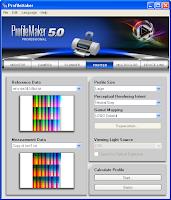USA-19HS Keyspan High-Speed USB to Serial Adapter
. Works with Windows and Mac OS
. Connects RS-232/DB9 (male) to USB Type A (male)
. No external power source required
. Compatible with Windows 98, 98 SE, Me, 2000, XP 32- and 64-bit,
2003 Server 32- and 64-bit, Vista 32- and 64-bit, and 7 32- and 64-bit
. Plug and play for Windows 7
Drivers download
xp and vista driver
Tuesday, July 12, 2011
Thursday, May 12, 2011
112 Test Chart for Canon SELPHY CP800 4R
The actual 4R print size for CP800 dyesub printer is 3.90"x5.45". The optimal number of patches that can be accommodated is 112, arranging in 14x8 matrix.
Optimal Layout for CP800 4R print size
112 patches could be placed with the following configuration, unit used is mm.
DefaultPatchWidth="10"
DefaultPatchHeight="7"
DefaultGapWidth=".1"
DefaultGapHeight="2"
DefaultHeaderLength="5"
DefaultTrailerLength="0"
Optimal Layout for CP800 4R print size
112 patches could be placed with the following configuration, unit used is mm.
DefaultPatchWidth="10"
DefaultPatchHeight="7"
DefaultGapWidth=".1"
DefaultGapHeight="2"
DefaultHeaderLength="5"
DefaultTrailerLength="0"
Thursday, March 31, 2011
Retrieving a Monaco Session with CP2
Restoring a Monaco session into CGATS format for PM5
Monaco session saves the colorimetric data in Lab values only, no spectral data was saved. Following procedure helps to recover the previously measured Lab values to CGATS file.
1. Open ColorPort2, go to Measure Target menu and select the appropriate target to be restored. Drag&drop the saved Monaco session data into CP2.
2. Save data in CGATS.
Do not save with PM5 option. The reason being that PM5 option saves both rgb and spectral data. The RGB data cannot be used for printer profiling.
CGATS option in CP2 saves data in RGB, Lab as well as spectral reflectance. Remember to select spectral value scale 0-100 as that is the default for PM5.
The spectral fields for both output options are null.
3. Open the saved file with a notepad editor. Delete the spectral field header, row count is optional, others untouched. Refer to the illustration for clarity.

4. Open PM5 ProfileMaker, assign the corresponding reference data and drag&drop the edited file. You are now ready to proceed to generate the icc profile.
Monaco session saves the colorimetric data in Lab values only, no spectral data was saved. Following procedure helps to recover the previously measured Lab values to CGATS file.
1. Open ColorPort2, go to Measure Target menu and select the appropriate target to be restored. Drag&drop the saved Monaco session data into CP2.
2. Save data in CGATS.
Do not save with PM5 option. The reason being that PM5 option saves both rgb and spectral data. The RGB data cannot be used for printer profiling.
CGATS option in CP2 saves data in RGB, Lab as well as spectral reflectance. Remember to select spectral value scale 0-100 as that is the default for PM5.
The spectral fields for both output options are null.
3. Open the saved file with a notepad editor. Delete the spectral field header, row count is optional, others untouched. Refer to the illustration for clarity.

4. Open PM5 ProfileMaker, assign the corresponding reference data and drag&drop the edited file. You are now ready to proceed to generate the icc profile.
Subscribe to:
Posts (Atom)




